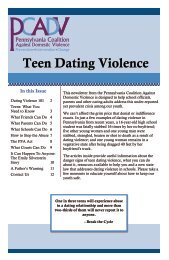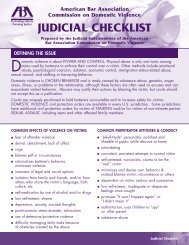Toolkit with Report Form - Pennsylvania Coalition Against Domestic ...
Toolkit with Report Form - Pennsylvania Coalition Against Domestic ...
Toolkit with Report Form - Pennsylvania Coalition Against Domestic ...
You also want an ePaper? Increase the reach of your titles
YUMPU automatically turns print PDFs into web optimized ePapers that Google loves.
Section five<br />
A Team Approach<br />
Most crisis response materials advocate for<br />
a team approach. It is important to have a<br />
team structure in place prior to an incident.<br />
Individuals should be familiar <strong>with</strong> both this<br />
toolkit and your program’s Critical Incident<br />
Response Plan. Individuals need the authority<br />
to carry out what needs to be done. The<br />
capacity for a team approach will be based<br />
on the resources <strong>with</strong>in each program<br />
and the person(s) affected by the incident.<br />
Flexibility and composition of the team are<br />
critical.<br />
Considerations For Developing<br />
A Team Approach:<br />
◗ Who is trained in crisis response or<br />
critical incident response?<br />
◗ What roles are reasonable for staff and<br />
volunteers to fill?<br />
◗ What happens if staff and volunteers<br />
were witnesses to the critical incident<br />
and/or are directly affected by the crisis<br />
situation?<br />
◗ What roles can members of your<br />
BOD fill?<br />
◗ Does staff have the means to adjust<br />
to the staffing changes (e.g. childcare if<br />
different hours/transportation if services<br />
moved to a different location)?<br />
◗ Does the diversity of program staff<br />
and those leading the critical incident<br />
response mirror that of the clients,<br />
families and community to whom you are<br />
responding?<br />
◗ What community resources might<br />
be available (assisted living facility for<br />
residents <strong>with</strong> special needs, other local<br />
domestic violence programs to handle<br />
hotline, counseling, support groups)?<br />
How can you solidify relationships <strong>with</strong><br />
them?<br />
Team Roles<br />
Every team needs a leader who will be<br />
the primary decision-maker. This is likely<br />
to be the executive director or her/his<br />
designee. The team leader needs to have<br />
crisis response training, the ability to<br />
maintain composure and a clear head when<br />
interacting <strong>with</strong> the media and the public and<br />
the authority to make decisions.<br />
Depending on the size of the program,<br />
several “liaisons” may be helpful in<br />
responding to the needs of staff, BOD<br />
volunteers, clients, their families and the<br />
public. Each of the following roles are<br />
important and could be assigned to one or<br />
more staff:<br />
◗ A staff liaison to serve as the direct line<br />
of communication between the team and<br />
all staff, BOD and volunteers needing<br />
to be informed during the response time<br />
following a critical incident.<br />
• They can also make sure that<br />
logistics, like where to continue<br />
providing services if the building is<br />
unavailable, are handled and that staff<br />
are having their own crisis reactions<br />
addressed.<br />
◗ A liaison(s) to work <strong>with</strong> clients,<br />
families and the public/media.<br />
◗ A liaison(s) to work <strong>with</strong> any<br />
designated group that may have specific<br />
needs to be addressed or that needs to<br />
know what’s happening as it unfolds.<br />
Liaisons should be considered<br />
the direct source of factual and<br />
timely information between the team and<br />
others.<br />
page 20<br />
When Crisis Strikes | <strong>Pennsylvania</strong> <strong>Coalition</strong> <strong>Against</strong> <strong>Domestic</strong> Violence | 2012








